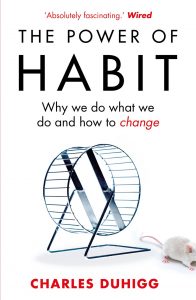
Habit loop
1. Cues
A trigger that drives your brain into automatic mode and which habit to apply. These cues can be anything. Such as visual, audible, emotional, etc.
2. Routines
An action that is repetitive in nature. This can be physical, mental, or emotional.
3. Rewards
The gratification your brain gets from completing the routine. This allows it to find a loop worth retaining for the future. Rewards can be physical and emotional.
Habits don’t really die. They’re embedded into the structures of our brain.
Keystone habits
There some habits that matter more than others in shaping our lives or businesses. These keystone habits determine how people work, eat, play, live, spend, and communicate. These habits have the ability to influence other existing habits as well.
The Golden Rule of habit change
Habits cannot be erased. Instead, it must be substituted.
According to this rule, you must:
1. Use the same old cue
2. Offer the same reward
3. Change the routine
Changing your habits
First and foremost, identify the components of your habit loops. From there, follow these four steps:
1. Identify the routine
Routine is the most explicit component of a habit. It’s the behaviour you want to change. Once identified, isolate the cues, and the reward, since the routine embodies the two.
2. Experiment with rewards
Find out which cravings stimulate specific habits. Experiment with different rewards. This will take weeks, or months even.
When you sense the desire to start the routine, modify it so that it offers a different reward. This will determine which craving is fueling your routine.
3. Isolate the cue
Most cues belong to one of 5 categories:
- Location
- Time
- Emotional state
- Other people
- Immediately preceding action
When experiencing an intense urge for a habit, try observing these five things at that moment.
4. Have a plan
When you see *cue*, do *routine* to get *reward*.
Break the loop by switching it up. Make a plan.
# Key Takeaways:
– Habits are formed through a loop of cue, routine, and reward.
– Habits can be changed by identifying and altering the cue and reward.
– Keystone habits have a ripple effect and can lead to positive changes in other areas of life.
– Willpower is a limited resource and can be strengthened through small wins and positive reinforcement.
– Social influence and peer pressure play a significant role in shaping habits.
– Organizations can create a culture of positive habits by focusing on small wins and creating a supportive environment.
# Practical Application:
– Identify the cue and reward for a habit you want to change and replace the routine with a healthier one.
– Use keystone habits to create positive changes in other areas of life.
– Break down larger goals into smaller, achievable tasks to build willpower and momentum.
– Surround yourself with people who have positive habits and avoid those who may influence you negatively.
– As a leader or manager, focus on creating a supportive and positive environment for your team to develop good habits.
# Valuable Insights for Leaders/Managers:
– Chapter 3: The Golden Rule of Habit Change
– understanding the cue and reward loop.
– Chapter 4: Keystone Habits, or the Ballad of Paul O’Neill
– how small changes can lead to significant transformations.
– Chapter 5: Starbucks and the Habit of Success
– creating a culture of positive habits in organizations.
– Chapter 6: The Power of a Crisis
– how a crisis can be an opportunity to change habits and create positive change.
# Case Studies/Examples:
– The story of Lisa Allen and how she changed her smoking habit by identifying the cue and reward.
– The success of Alcoa under the leadership of Paul O’Neill, who focused on safety as a keystone habit.
– The transformation of Starbucks under Howard Schultz, who focused on creating a culture of positive habits.
– The story of Tony Dungy and how he used positive reinforcement to build a winning team.
Leave a Reply